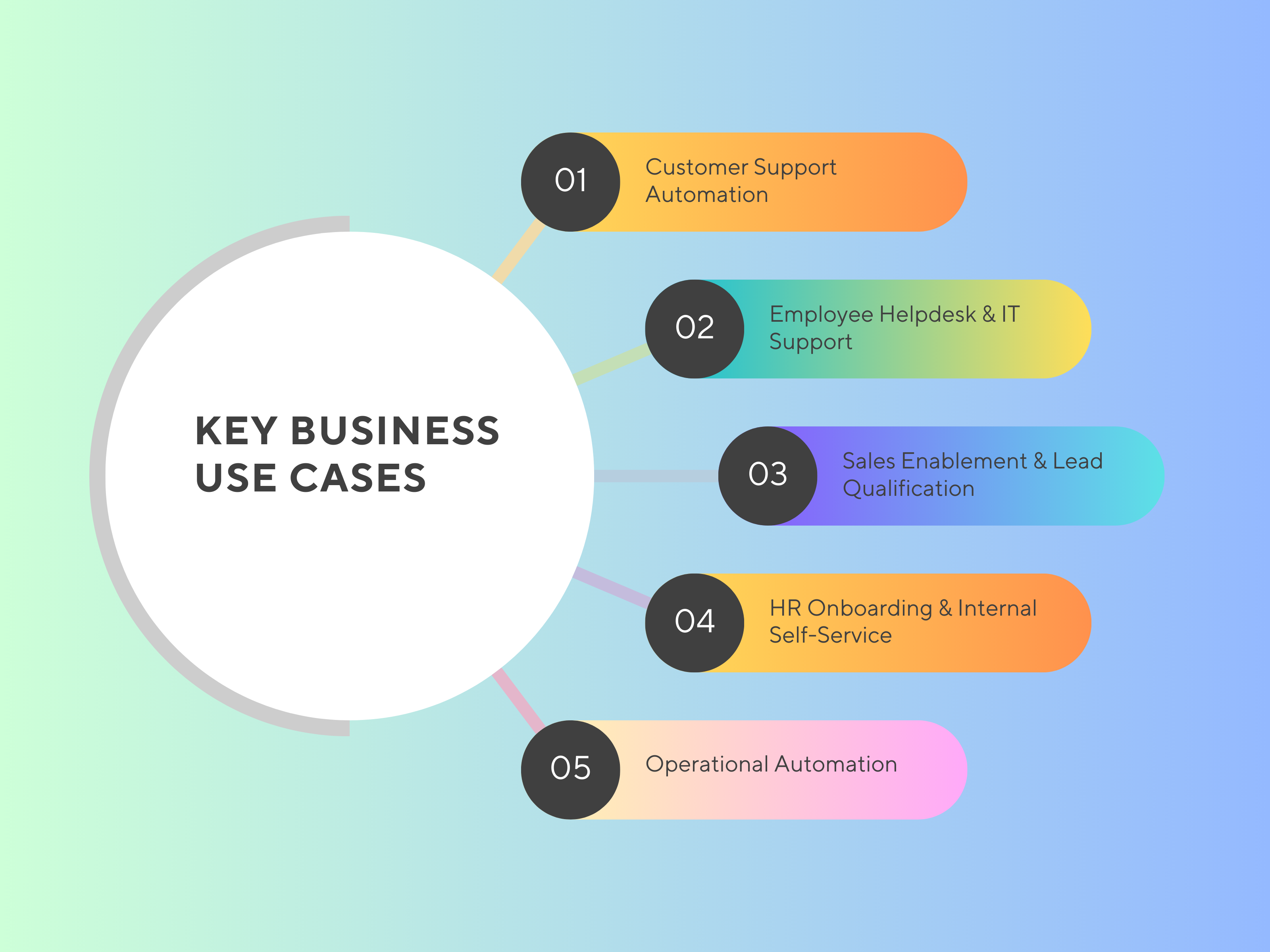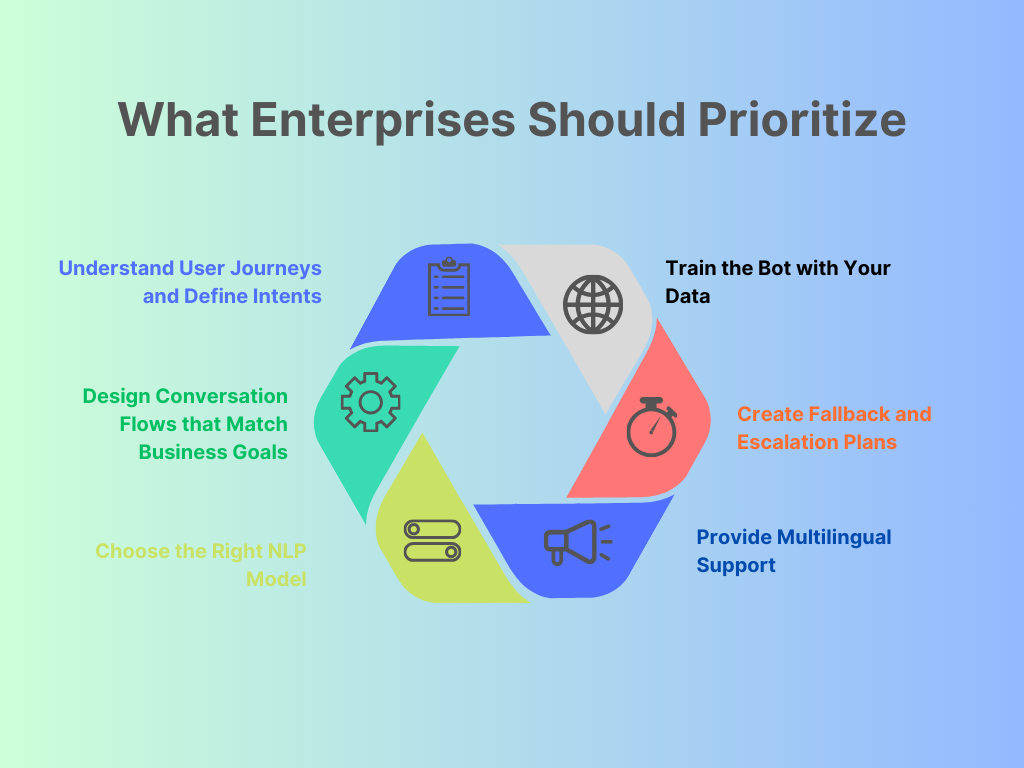The Ultimate Guide to Conversational AI for Enterprises
Conversational AI for enterprises is transforming how large organizations handle support, optimize business processes, and complex customer interactions. This guide explains its use cases, benefits, best practices, implementation roadmap, and future trends, helping leaders adopt AI strategically and drive measurable business impact.

Nearly 70% of customers expect companies to understand their needs without them repeating information. But most large organizations still struggle with fragmented systems and long response times.
This gap is exactly what conversational AI for enterprises is solving. It is bringing intelligent automation into everyday conversations.
Conversational AI is one of the subsets of AI and refers to a technology that uses AI to communicate with users.
Leaders want faster responses, lower support costs, and consistent service across channels, and AI is finally mature enough to deliver all three. Instead of basic chatbots, companies are now deploying intelligent systems with strong integration capabilities that understand user intent, personalize answers, and automate routine work without sacrificing quality.
As expectations grow and teams face the need to achieve more with fewer resources, conversational AI is becoming a valuable investment for businesses.
 Generate
Key Takeaways
Generating...
Generate
Key Takeaways
Generating...

-
Conversational AI helps enterprises cut operating costs while improving customer experience.
-
Modern enterprises use AI assistants to automate customer support, HR, IT helpdesk, and workflows.
-
Strategic AI adoption accelerates digital transformation across enterprise functions.
-
Conversational AI strengthens enterprise efficiency with 24/7 automated assistance.
-
Enterprise chatbots reduce resolution time and boost workforce productivity at scale.
-
Conversational AI ensures faster, more accurate decision-making across departments.
-
Future-ready enterprises leverage multimodal and autonomous AI for deeper automation.
What Is Conversational AI for Enterprises?
Conversational AI for enterprises is an intelligent system accessible via chat, voice, or messaging that understands natural language, maintains context, and automates responses across customer and employee interactions.
How enterprise-grade conversational AI differs from basic chatbots?
Traditional chatbots follow strict rules. They respond in set ways, like “If you ask A, respond X.” They struggle when conversations go off this script. In contrast, enterprise-grade systems go beyond. They understand what users want, adapt to new questions, and pass the conversation to a human when needed. They also integrate with back-end systems, enterprise data, compliance frameworks, and enterprise workflows that basic bots typically do not.
Move Beyond Traditional Chatbots & Build Enterprise Intelligence
Modern conversational AI understands context, triggers customer journey workflows, and drives outcomes.
Key Business Use Cases of Conversational AI in Enterprises
Using conversational AI in businesses goes beyond just handling frequently asked questions, enabling personalized customer interactions. It can significantly change how a company operates. Here are the main ways the power of conversational AI adds value for large organizations:

1. Customer Support Automation
AI-driven agents work around the clock to handle common support questions. This reduces wait times, lowers the number of support tickets, and allows human agents to focus on more complex issues. Studies show that virtual assistants can cut handling times by up to 40% and deliver improved customer interactions.
2. Employee Helpdesk & IT Support
Conversational AI helps employees quickly resolve common IT and HR issues, such as password resets and software access. This helps lighten the load on internal helpdesk teams and speeds up problem resolution.
3. Sales Enablement & Lead Qualification
Chatbots can engage potential customers in real time, ask questions to gauge interest, score leads, and even schedule meetings. Automating these early conversations ensures that sales teams focus only on high-potential prospects.
4. HR Onboarding & Internal Self-Service
New employees often have basic questions such as, “When is payroll processed?” or “How do I apply for leave?” Conversational AI answers these questions right away. This streamlines the onboarding process and reduces repetitive HR tasks.
5. Operational Automation
Beyond support, conversational AI can start workflows like creating purchase orders, checking invoice status, or asking about inventory, all through chat. This reduces manual processes, lowers the chance of human error, and speeds up operations.
Automate Customer & Employee Conversations at Scale
See how large-scale enterprises cut support load by 40% using conversational AI.
Benefits of Deploying Conversational AI at Enterprise Scale
Deploying conversational AI for enterprises isn’t just a tech upgrade. It is a strategic move that delivers measurable business value across multiple fronts:
- Faster Response times & 24/7 Availability
Conversational AI agents can handle customer and employee queries around the clock through natural language understanding, and that too far beyond traditional work hours. This continuous availability ensures no critical issue waits, improving responsiveness and service reliability. - Reduced Operational Costs
According to Gartner, by 2026, conversational AI could reduce contact center agent labor costs by $80 billion globally. So, implementing conversational AI can reduce overall operational costs. - Improved Customer Satisfaction and Experience
Conversational AI provides quick, accurate, and relevant responses. It handles simple questions, which allows human agents to focus on more complicated issues. - Better data-Driven decision-Making
AI-driven conversations provide useful insights. Companies can look at trends, feelings, and intentions to make better decisions. This helps them improve products, marketing, and internal processes. - Higher Workforce Productivity Through Automation
Using conversational AI for routine tasks like password resets and status checks lightens the load on staff by analyzing user behavior. This allows human teams to concentrate on more important and complex work. - Enhanced Personalization with Contextual Responses
Enterprise systems can integrate user history and past interactions with business data to personalize AI conversations. This means customers or employees don't just get generic replies. They get responses tailored to their context, increasing relevance and customer satisfaction.
Your Customers Expect Speed and AI Delivers It
Meet the rising demand for instant, accurate, 24/7 responses.
Choosing the Right Enterprise Conversational AI Platform
Choosing the right conversational AI platform for your business is crucial. It can either give you a strong advantage or lead to failure. Here are the main factors to consider:
- Scalability for Large Teams
The platform should manage thousands of conversations at once without slowing down. This is important as your business grows, especially when using AI in support, HR, sales, and operations.
- Data Security & Compliance
With increasing focus on security, it’s essential not to overlook it. Make sure the AI platform supports encryption, access controls, and complies with regulations like CCPA, GDPR and ISO.
- Multichannel Deployment
Your conversational AI should reach customers and employees on their preferred platforms. Look for systems that work across web chat, mobile apps, WhatsApp, email, Slack, CRM, and ERP.
- Seamless Integration with Existing Systems
The best AI platforms work well with your existing tools like CRM, ITSM, HRMS, knowledge bases, and internal APIs. This allows the AI to automate tasks such as creating tickets, updating records, and retrieving customer information without needing human help.
- Customization & Advanced Automation Features
Top platforms let you customize workflows, create specific intents, and automate multi-step processes. This allows you to go beyond basic FAQs and achieve full automation in various business areas.
- Analytics, Training Dashboards & Governance Controls
It's important for leaders to see what's effective. Choose platforms that provide conversation analytics, training dashboards, sentiment trends, and governance controls to maintain quality as usage increases.
Building Enterprise Chatbots: What Enterprises Should Prioritize
When you build enterprise ai powered chatbots, you’re not just making a bot for common questions. You’re creating a key tool that helps your business. Here are six important steps to ensure your chatbot is effective, reliable, and can grow with your needs:

1. Understand User Journeys and Define Intents
Start by looking at how your customers or employees interact with your business. Identify their main reasons for asking questions, user engagement patterns, or making requests.
2. Design Conversation Flows that Match Business Goals
Each chat path should support your business aims, like qualifying leads, reducing support requests, or improving onboarding. Focus on realistic user flows, not just basic chat paths.
3. Choose the Right NLP Model
Not all Natural Language Processing (NLP) models work the same way. For your business, you need an accurate model that understands your field and can grow with you. It should grasp specific terms, slang, and context-aware interactions.
4. Train the Bot with Your Data
The chatbot performs better when it learns from your actual data, such as past support tickets and internal documents. This helps the bot feel familiar with your business rather than just answering general questions.
5. Create Fallback and Escalation Plans
Even the best chatbot will encounter tough or unexpected questions. Plan for fallback responses, like “I don’t understand,” and ensure smooth transitions to human agents when needed. This builds trust and prevents confusion.
6. Provide Multilingual Support for Global Teams
If your company operates globally, your chatbot needs to handle multiple languages. Using multilingual models makes sure you are not just automating responses but also providing consistent and caring service across different countries.
Build Your Enterprise-Grade Conversational AI Assistant
Our AI experts help you design, deploy, and scale confidently.
Conversational AI Best Practices for Successful Deployment
When launching conversational AI technology in companies, having a clear plan is more important than just building the technology. Here are six best practices to make artificial intelligence deployment easier, scalable, and valuable:
1. Start Small, Then Scale
Begin with a pilot project in a key area like customer service or human resources. This lets you test, learn, and improve before expanding to other departments.
2. Focus on Important Workflows First
Choose use cases that deliver clear business benefits, such as automating common support questions or onboarding tasks. Early successes build trust with leadership and justify more investment.
3. Keep a Clear Management Structure
Clarify who is in charge of the conversational AI project: product teams, IT, or business teams. Set clear roles, goals, and paths for addressing issues so that decisions about training, data, and performance happen proactively.
4. Test, Retrain, and Optimize Regularly
Conversational AI needs ongoing attention. Regularly review chat logs, retrain your models, and improve interaction flows to enhance understanding. This helps increase accuracy, customer engagement and reduce problems over time.
5. Analyze Conversation Drop-offs
Use analytics to see where conversations get stuck, fail, or need human intervention. These insights help you identify weak spots, refine fallback plans, and improve user satisfaction.
6. Be Honest in AI Interactions
Always let users know when they are interacting with a bot. Provide an option to reach a human if necessary. Being transparent builds trust, especially in customer service and sensitive situations.
7. Continuously Monitor and Improve
This involves tracking key metrics, such as customer satisfaction, conversation completion rates, and task success rates, to assess the system's performance.
8. Invest in High-Quality Data
Investing in high-quality data is paramount for the success of any Conversational AI system.
Train your AI model on a robust and representative dataset to ensure that the system can understand and respond to your users' input effectively, leading to more accurate and meaningful interactions.
By regularly analysing user interactions and identifying areas for improvement, you can refine your business AI model, address shortcomings, and enhance the overall user experience.
According to IBM's Global AI Adoption Index, about 42% of large companies are already using AI, while nearly 40% are still testing it.
By following these best practices from the start, leaders can move from pilot projects to wide-scale deployment of conversational AI with clarity and control.
The Conversational AI Implementation Roadmap for Large Enterprises
Deploying conversational AI for enterprises at scale requires a structured, phased approach in chatbot development. Here is a practical, enterprise-ready roadmap to deploy conversational AI for enterprises in a structured, scalable way:
- Opportunity Assessment & Capability Discovery
Identify your main business goals, such as reducing support tickets or speeding up onboarding. Also, note user pain points and look for ways to automate tasks. Track your current metrics, like customer queries response times and ticket volume, so you can measure the impact of your changes. - Strategy
Create a plan for your AI powered chatbot development. Start by choosing which channels to use, such as a website, mobile app, or WhatsApp. Then decide on the chatbot's purpose, like customer support or helping employees. Finally, set important goals to measure success, such as how many questions the chatbot can handle without human help, how quickly it solves problems, and the cost for each chat. - Platform Selection
Choose an enterprise-grade conversational AI tools and platform that can scale, integrate with your systems, and align with your security and compliance needs. - Design & Development
Create conversational AI interfaces, flows and intents that match the business needs. Train your models using relevant data, such as support tickets and internal knowledge. Connect the chatbot to your CRM, ERP, or helpdesk tools. - Testing & Optimization
Check that the intents work, handle any special cases, and adjust fallback or escalation paths as needed. Keep improving based on real conversation logs to ensure the bot understands well and provides effective help. - Deployment Across Departments
Roll out the chatbot in important areas like customer support and HR first, instead of everywhere at once. Use feedback from early users to fix any issues. - Monitoring & Scaling
Regularly check performance using analytics. Look at how often the tool is used, where users drop off, how quickly issues are resolved, and how many cases need to be escalated.
As the bot shows its benefits, expand automation workflows to more teams or use cases.
According to Gartner, 85% of customer service leaders will look into or test customer-facing conversational GenAI. This shows that structured pilot programs are becoming common. Starting with a clear plan reduces risks and helps your investment grow wisely, not just quickly.
The Future of Conversational AI for Enterprises
Companies are moving beyond basic chatbots, and the future of conversational AI in businesses is becoming more advanced with large language models. This new AI will be smarter, more autonomous, and closely integrated into everyday business tasks. Here are the key trends to watch:
1. Autonomous Agents
Business leaders are preparing for AI that can take action rather than just respond. Autonomous agents can handle tasks like booking meetings, processing simple transactions, and answering customer questions without needing help from people. Deloitte reports that more than 25% of companies are already using this "agentic AI" in real business activities.
2. Multi-Modal AI
Conversational AI isn't just about text anymore. Companies are creating multimodal conversational AI systems that use voice, text, images, and even video together. This future with multiple input types allows for better interactions.
3. Hyper-Personalization
Due to improvements in data management, future conversational AI will provide personalized interactions. By using a user's history, behavior, and preferences, AI agents can give responses that feel more like talking to a trusted advisor instead of a scripted bot.
4. Predictive & Proactive Assistance
Tomorrow's AI will not just respond to needs; it will predict them and take action early. For instance, an enterprise bot can proactively remind customers of billing issues or prompt sales reps to follow up on leads, transforming conversations into valuable interactions.
5. Voice-Driven Enterprise Automation
Voice AI is becoming more important in businesses. A report from Deepgram shows that by 2025, 92% of companies will collect speech data, and 67% see voice AI as a key part of their strategy.
The Future of Enterprise Automation Is Conversation-Led
Voice, chat, and multimodal AI are transforming enterprise workflows faster than ever; make sure you're out in front, not catching up.
Final Thoughts
Conversational AI for businesses is no longer a "future technology." It is becoming essential for change in organizations. The move towards AI-powered conversations is already happening.
However, simply using AI powered chatbot is not enough for success. You need a clear plan, a roadmap, and the commitment to expand on what works. Businesses that start small, by focusing on valuable tasks like customer support, IT help, or employee self-service, often see quick returns on investment and easier use.
As conversation AI technology evolves, working with the right AI development company can help organizations accelerate this process, avoid common mistakes, and create custom conversational AI solutions that align with their business goals. The enterprises that invest in conversational AI today will be the ones that lead in customer experience, operational efficiency, and digital resilience tomorrow.
Frequently Asked Questions
Have a question in mind? We are here to answer. If you don’t see your question here, drop us a line at our contact page.
What is the best Conversational AI Platform?
![]()
The best conversational AI platform depends on an enterprise’s needs, but leading options include OpenAI, Google Dialogflow, Microsoft Copilot Studio, IBM Watson Assistant, and Salesforce Einstein Bots.
Is ChatGPT a Conversational AI?
![]()
Yes. ChatGPT is a conversational AI model built by OpenAI. It understands natural language, generates human-like responses, and can assist with tasks such as customer support, content generation, data analysis, and workflow automation.
What is the difference between a chatbot and conversational AI?
![]()
A chatbot follows predefined rules or scripts; if the input doesn’t match its programmed path, it often fails.
Conversational AI, on the other hand, uses advanced NLP and machine learning to understand intent, maintain context, personalize responses, and automate workflows. It can handle complex, multi-step conversations and integrate with enterprise systems, making it far more powerful than a traditional rule-based chatbot.
What is an Example of Conversational AI?
![]()
A common example is an AI-powered virtual assistant that helps customers check order status, file support tickets, update personal information, or access HR/IT helpdesk services.



.png?width=344&height=101&name=Mask%20group%20(5).png)
















